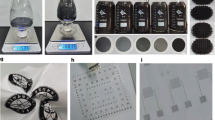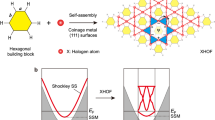Abstract
Nanocrystals are under active investigation because of their interesting size-dependent properties1,2 and potential applications3,4,5. Silicon nanocrystals have been studied for possible uses in optoelectronics6, and may be relevant to the understanding of natural processes such as lightning strikes7. Gas-phase methods can be used to prepare nanocrystals, and mass spectrometric techniques have been used to analyse Au8,9 and CdSe clusters10. However, it is difficult to study nanocrystals by such methods unless they are synthesized in the gas phase11. In particular, pre-prepared nanocrystals are generally difficult to sublime without decomposition. Here we report the observation that films of alkyl-capped silicon nanocrystals evaporate upon heating in ultrahigh vacuum at 200 °C, and the vapour of intact nanocrystals can be collected on a variety of solid substrates. This effect may be useful for the controlled preparation of new quantum-confined silicon structures and could facilitate their mass spectroscopic study and size-selection12.
This is a preview of subscription content, access via your institution
Access options
Subscribe to this journal
Receive 12 print issues and online access
$259.00 per year
only $21.58 per issue
Buy this article
- Purchase on Springer Link
- Instant access to full article PDF
Prices may be subject to local taxes which are calculated during checkout




Similar content being viewed by others
References
Banin, U. & Millo, O. Tunneling and optical spectroscopy of semiconductor nanocrystals. Annu. Rev. Phys. Chem. 54, 465–492 (2003).
Murray, C. B., Norris, D. J. & Bawendi, M. G. Synthesis and characterization of nearly monodisperse CdE (E = sulfur, selenium, tellurium) semiconductor nanocrystallites. J. Am. Chem. Soc. 115, 8706–8715 (1993).
Bruchez, M. J., Moronne, M., Gin, P., Weiss, S. & Alivisatos, A. P. Semiconductor nanocrystals as fluorescent biological labels. Science 281, 2013–2016 (1998).
Chan, W. C. W. & Nie, S. Quantum dot bioconjugates for ultrasensitive nonisotopic detection. Science 281, 2016–2018 (1998).
Kim, S. et al. Near-infrared fluorescent type II quantum dots for sentinel lymph node mapping. Nat. Biotechnol. 22, 93–97 (2004).
Pavesi, L., Dal Negro, L., Mazzoleni, C., Franzò, G. & Priolo, F. Optical gain in silicon nanocrystals. Nature 408, 440–444 (2000).
Abrahamson, J. & Dinniss, J. Ball lightning caused by oxidation of nanoparticle networks from normal lightning strikes on soil. Nature 403, 519–521 (2000).
Schaaff, T. G., Shafigullin, M. N., Khoury, J. T., Vezmar, I. & Whetten, R. L. Isolation of smaller nanocrystal Au molecules: robust quantum effects in optical spectra—MALDI MS of nanoparticles. J. Phys. Chem. B 101, 7885–7891 (1997).
Serna, R. et al. Matrix assisted laser desorption/ionisation studies of metallic nanoclusters produced by pulsed laser deposition. Appl. Surf. Sci. 129, 383–387 (1998).
Kasuya, A. et al. Ultra-stable nanoparticles of CdSe revealed from mass spectrometry. Nature Mater. 3, 99–102 (2004).
Ledoux, G., Gong, J., Huisken, F., Guillois, O. & Reynaud, C. Photoluminescence of size-separated silicon nanocrystals: Confirmation of quantum confinement. Appl. Phys. Lett. 80, 4834–4836 (2002).
Reboredo, F. A. & Galli, G. Theory of alkyl-terminated silicon quantum dots. J. Phys. Chem. B 109, 1072–1078 (2005).
Lie, L. H., Duerdin, M., Tuite, E. M., Houlton, A. & Horrocks, B. R. Preparation and characterisation of luminescent alkylated silicon quantum dots. J. Electroanal. Chem. 538, 183–190 (2002).
Lie, L. H. et al. Immobilisation and synthesis of DNA on Si(111), nanocrystalline porous silicon and silicon nanoparticles. Faraday Discuss. 125, 235–249 (2004).
Ding, Z. F. et al. Electrochemistry and electrogenerated chemiluminescence from silicon nanocrystal quantum dots. Science 296, 1293–1297 (2002).
Li, X. G., He, Y. Q. & Swihart, M. T. Surface functionalization of silicon nanoparticles produced by laser-driven pyrolysis of silane followed by HF-HNO3 etching. Langmuir 20, 4720–4727 (2004).
Li, Z. F. & Ruckenstein, E. Water-soluble poly(acrylic acid) grafted luminescent silicon nanoparticles and their use as fluorescent biological staining labels. Nano Lett. 4, 1463–1467 (2004).
Pettigrew, K. A., Liu, Q., Power, P. P. & Kauzlarich, S. M. Solution synthesis of alkyl- and alkyl/alkoxy-capped silicon nanoparticles via oxidation of Mg2Si. Chem. Mater. 15, 4005–4011 (2003).
Warner, J. H., Hoshino, A., Yamamoto, K. & Tilley, R. D. Water-soluble photoluminescent silicon quantum dots. Angew. Chem. Int. Edn 44, 4550–4554 (2005).
Nayfeh, M. H. et al. Stimulated blue emission in reconstituted films of ultrasmall silicon nanoparticles. Appl. Phys. Lett. 78, 1131–1133 (2001).
Sweryda-Krawiec, B., Cassagneau, T. & Fendler, J. H. Surface modification of silicon nanocrystallites by alcohols. J. Phys. Chem. B 103, 9524–9529 (1999).
Faucheux, A. et al. Thermal decomposition of alkyl monolayers covalently grafted on (111) silicon. Appl. Phys. Lett. 88, 193123 (2006).
Sung, M. M., Kluth, G. J., Yauw, O. W. & Maboudian, R. Thermal behavior of alkyl monolayers on silicon surfaces. Langmuir 13, 6164–6168 (1997).
Chao, Y. et al. Reactions and luminescence in passivated Si nanocrystals induced by vacuum ultraviolet and soft-x-ray photons. J. Appl. Phys. 98, 044316 (2005).
Linford, M. R., Fenter, P., Eisenberger, P. M. & Chidsey, C. E. D. Alkyl monolayers on silicon prepared from 1-alkenes and hydrogen-terminated silicon. J. Am. Chem. Soc. 117, 3145–3155 (1995).
Ebenstein, Y., Nahum, E. & Banin, U. Tapping mode atomic force microscopy for nanoparticle sizing: Tip–sample interaction effects. Nano Lett. 2, 945–950 (2002).
Ashurst, W. R., Carraro, C. & Maboudian, R. Vapor phase anti-stiction coatings for MEMS. IEEE Trans. Device Mater. Reliab. 3, 173–178 (2003).
Nishida, N., Hara, M., Sasabe, H. & Knoll, W. Dimerization process in alkanethiol self-assembled monolayer on Au(111). Jpn J. Appl. Phys. 35, L799–L802 (1996).
Acknowledgements
The Engineering and Physical Sciences Research Council (EPSRC) and the Centre of Excellence for Nanotechnology, Micro and Photonic Systems (CeNAMPs) are acknowledged for funding this work. We also acknowledge the European Commission Access to Research Infrastructure (EC-ARI) programme support for work undertaken at MAXLAB. The advice of D. Robbins is appreciated. J. G. Grossmann (Council for the Central Laboratory of the Research Councils (CCLRC)) Daresbury Laboratory, Daresbury, Warrington, Cheshire, UK) and K. Liddell (School of Chemical Engineering and Advanced Materials, University of Newcastle upon Tyne) are thanked for their help with SAXS and X-ray diffraction measurements, respectively.
Author information
Authors and Affiliations
Contributions
L.S. and Y.C. developed the evaporation apparatus; Y.C. carried out AFM, Raman and photoluminescence measurements. Y.C., L.S., S.K. and L.K. performed photoemission studies, P.R.C., U.B. and M.G. carried out TEM imaging and EEL spectra. L.H.L., N.O'F. and T.A.A. developed the preparation method and FTIR characterization. Y.C. and T.A.A. carried out SAXS measurements. S.N.P. characterized the samples by STM. L.S., Y.C., A.H. and B.R.H. analysed data and wrote the manuscript. All authors discussed the results and commented on the manuscript.
Corresponding authors
Ethics declarations
Competing interests
The authors declare no competing financial interests.
Supplementary information
Supplementary Information
Supplementary methods, table and figures S1–S16 (PDF 2466 kb)
Rights and permissions
About this article
Cite this article
Chao, Y., Šiller, L., Krishnamurthy, S. et al. Evaporation and deposition of alkyl-capped silicon nanocrystals in ultrahigh vacuum. Nature Nanotech 2, 486–489 (2007). https://doi.org/10.1038/nnano.2007.224
Received:
Accepted:
Published:
Issue Date:
DOI: https://doi.org/10.1038/nnano.2007.224
This article is cited by
-
Anti-cancer activities of allyl isothiocyanate and its conjugated silicon quantum dots
Scientific Reports (2018)
-
Luminescence nanothermometry with alkyl-capped silicon nanoparticles dispersed in nonpolar liquids
Nanoscale Research Letters (2014)
-
A top–down strategy towards monodisperse colloidal lead sulphide quantum dots
Nature Communications (2013)
-
The effect of alkyl chain length on the level of capping of silicon nanoparticles produced by a one-pot synthesis route based on the chemical reduction of micelle
Journal of Nanoparticle Research (2013)
-
Synthesis of water-dispersible photoluminescent silicon nanoparticles and their use in biological fluorescent imaging
Journal of Nanoparticle Research (2011)



